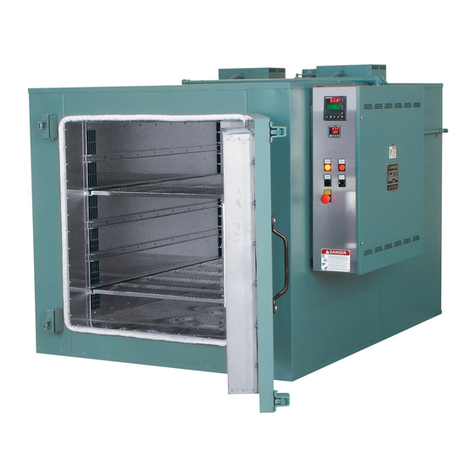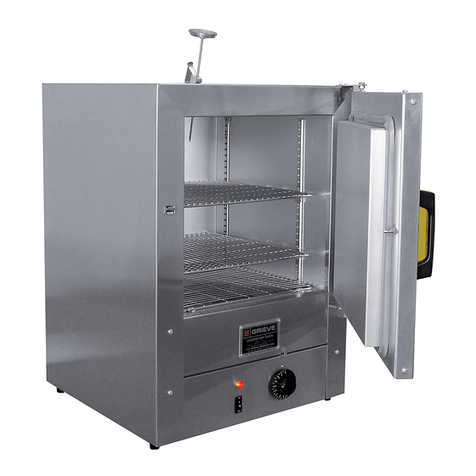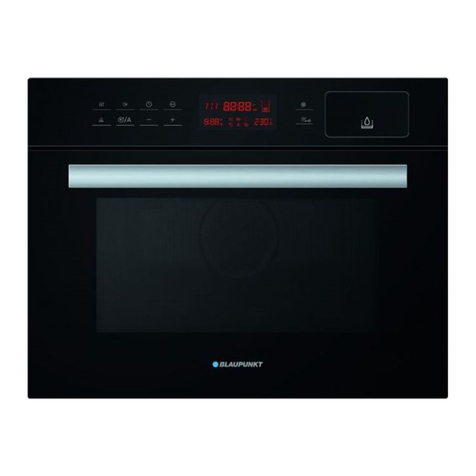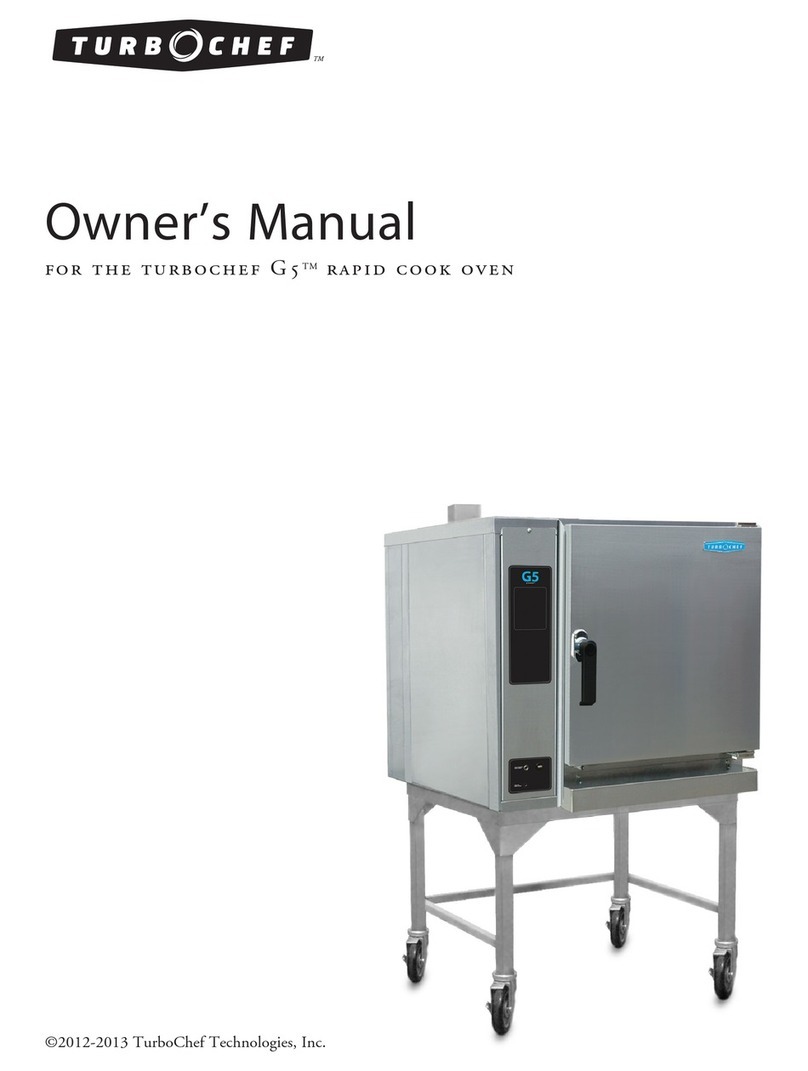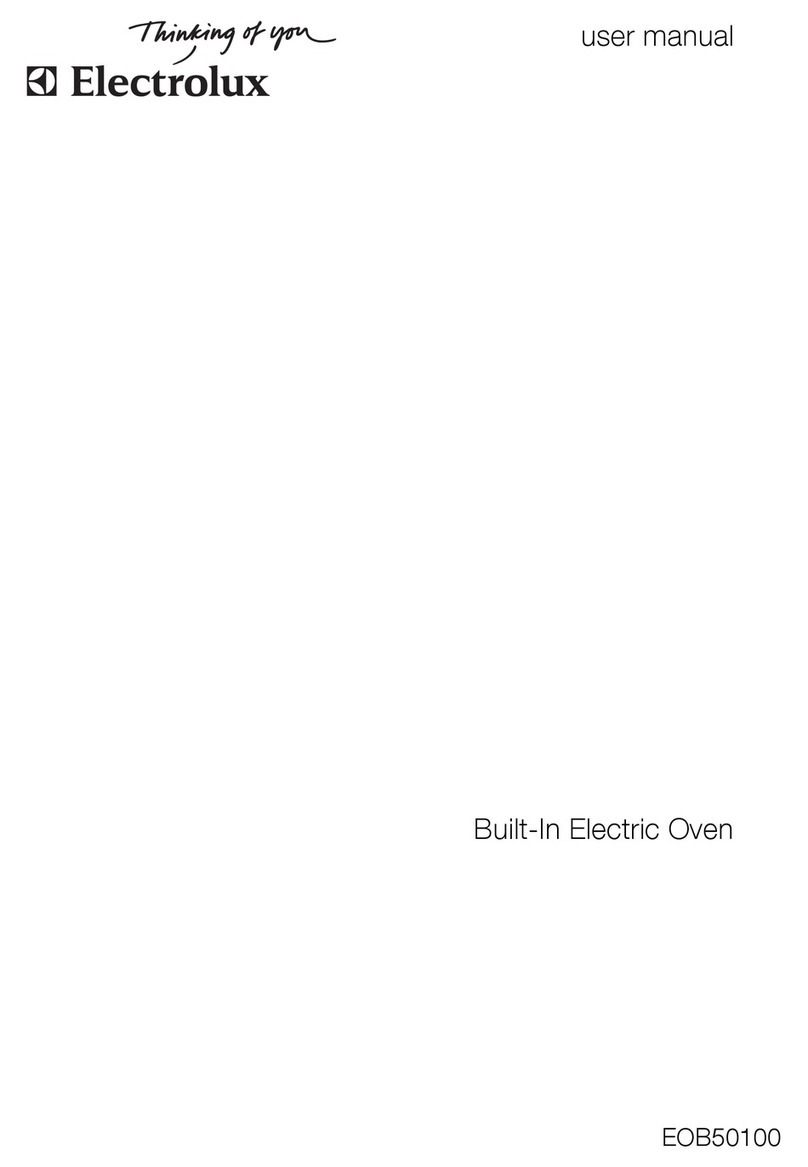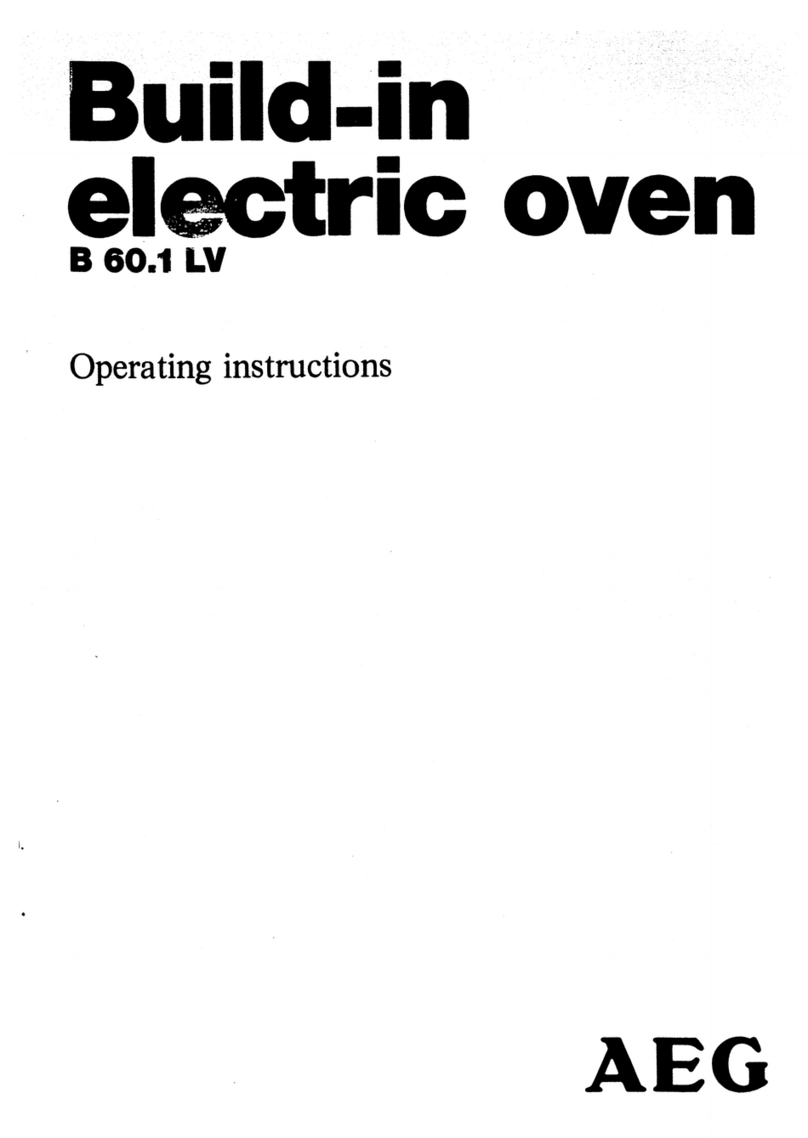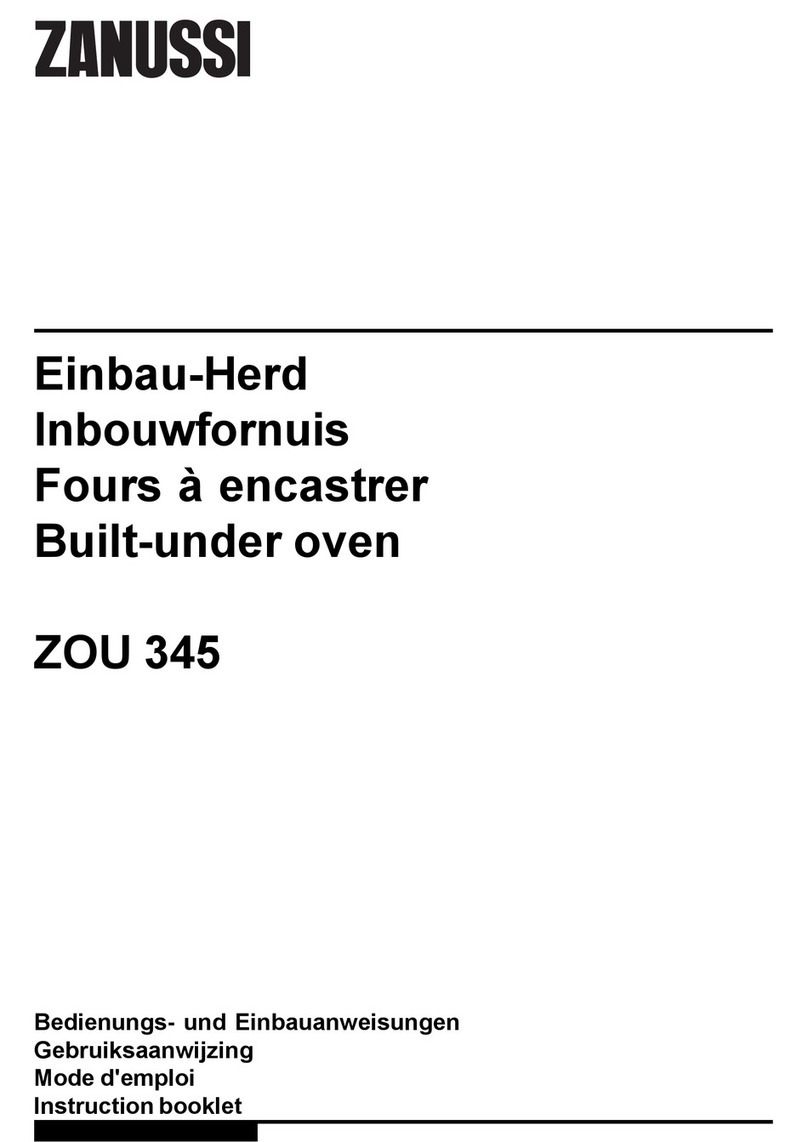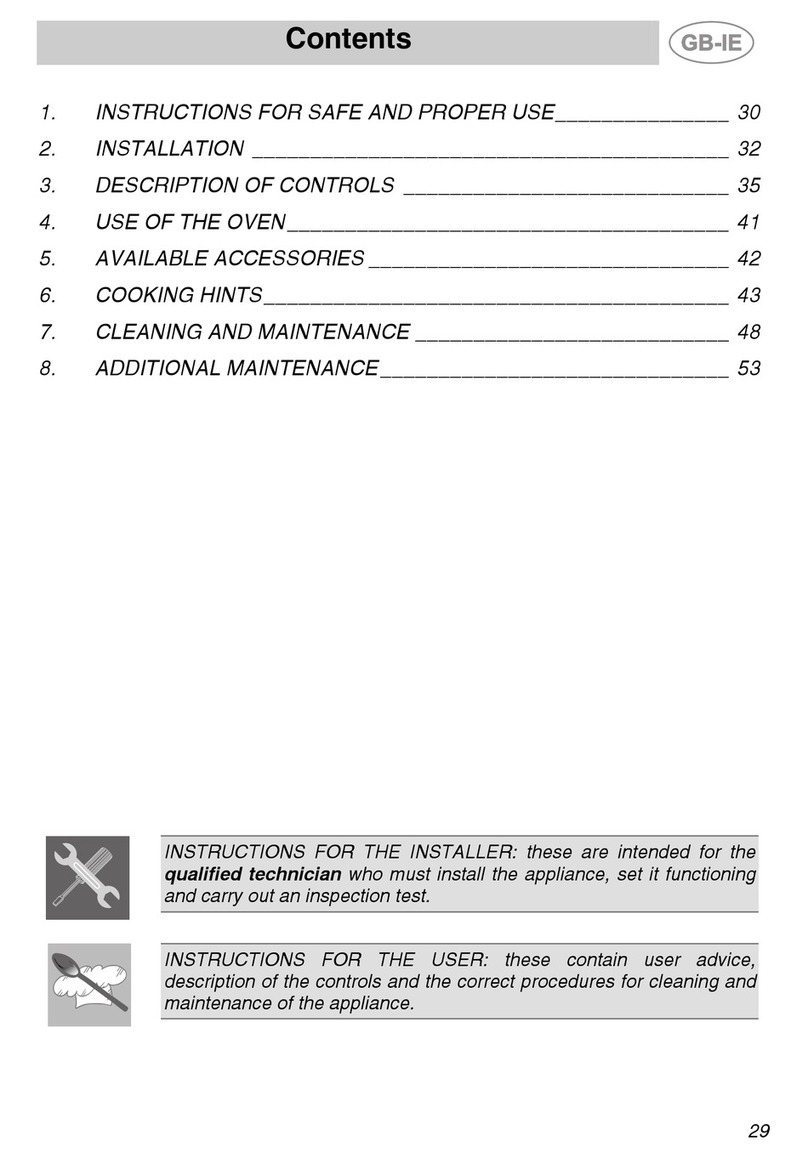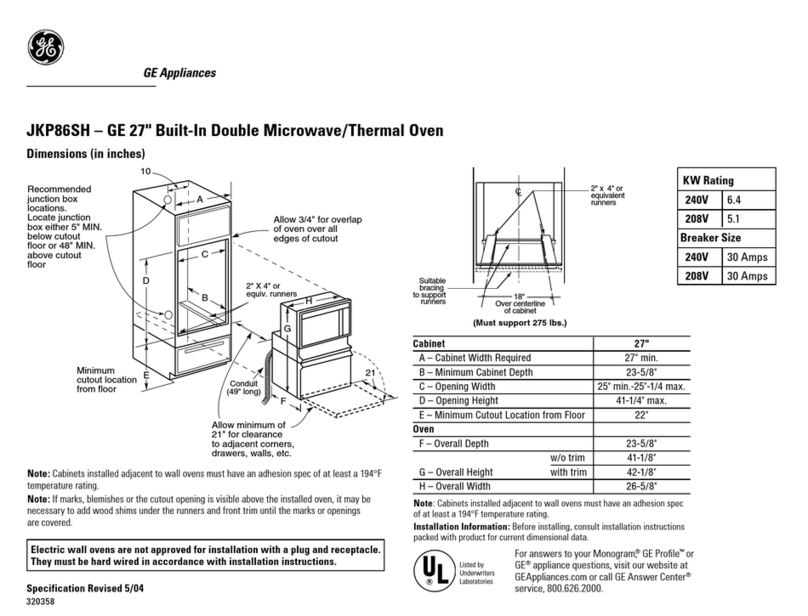Grieve NB-350 User manual

INSTRUCTIONS
BENCH OVENS
MAXIMUM
MODEL OPERATING TEMPERATURE
NB-350 350EF
DR-350 350EF
NB-550 550EF
NT-800 800EF
NTR-800 800EF
NT-1000 1000EF
NTR-1000 1000EF

BENCH OVEN GENERAL INSTALLATION, OPERATION AND
MAINTENANCE INSTRUCTIONS FOR
MODELS NB-350, DR-350, NB-550, NT-800,
NTR-800, NT-1000 AND NTR-1000
TABLE OF CONTENTS
1 SHIPPING DAMAGE & HANDLING
2 PROPER OVEN APPLICATION
2-1 General
2-2 Flammable Solvents
2-3 Combustible Material
2-4 Personnel Hazards
2-5 Maintenance and Inspection
3 INSTALLATION
3-1 Location
3-2 Building Considerations
3-3 Clearances
3-4 Ventilation
3-5 Exhaust Ductwork
3-6 Thermometer
3-7 Electrical
4 PRIOR TO PLACING OVEN IN SERVICE
5 PROCESSING
6 SAFETY EQUIPMENT
7 MAINTENANCE
8 TROUBLE SHOOTING
9 APPENDIX A - REFERENCES
10 APPENDIX B - MINIMUM PERIODIC MAINTENANCE REPORT
11 APPENDIX C - REPLACEMENT PARTS LIST
11 APPENDIX D - WARRANTY AND LIMITATIONS OF REMEDIES
These GENERAL INSTRUCTIONS have been written for many different types of ovens,
therefore, some equipment or components referred to may not be present on your particular
piece of equipment.

3 of 23 08/18
W:\ELECTRICAL\MANUAL\BENCH\GENERAL INSTRUCTIONS\BENCHOVEN INS.8-18
1 SHIPPING DAMAGE AND HANDLING
DO NOT RETURN DAMAGED MERCHANDISE TO US.
FILE YOUR CLAIM AS OUTLINED BELOW
This merchandise has been thoroughly inspected and carefully packed before leaving
our plant. Responsibility for its safe delivery was assumed by the carrier at the time of
shipment. Claims for loss or damage to the contents must be made with the carrier, as
follows:
1-1 VISIBLE LOSS OR DAMAGE
Any external evidence of loss or damage must be noted, at the time of delivery, on
the freight bill or express receipt and signed by the carrier's agent. Failure to
adequately describe such external evidence of loss or damage may result in the
carrier refusing to honor a damage claim. Make a written request for inspection by
the carrier's agent within fifteen days of the delivery date. Review the inspection
report and do not sign it unless it adequately describes the damage.
A claim must be filed with the carrier since such damage is the carrier's
responsibility.
1-2 CONCEALED LOSS OR DAMAGE
Concealed loss or damage means loss or damage which does not become
apparent until the merchandise has been unpacked. The contents may be
damaged in transit due to rough handling even though the carton may not show
external damage. When the damage is discovered upon unpacking, contact the
carrier and make a written request for inspection by the carrier's agent within
fifteen days of the delivery date. Review the inspection report and do not sign it
unless it adequately describes the damage.
A claim must be filed with the carrier since such damage is the carrier's
responsibility. By following these instructions carefully, we guarantee our full
support of your claims to protect you against loss from concealed damage.
1-3 RETURNING DAMAGED EQUIPMENT
Damaged equipment will not be accepted at our factory unless we have been
advised and instructions provided on how it should be returned. A copy of the
freight claim must be provided prior to returning the equipment.
1-4 HANDLING
After inspection, store and handle all equipment and components in their original
crates until ready for installation. Handle with care. The equipment may be heavy
but some components are of a delicate nature. If the equipment is to be stored,
keep it in the original crates and store in a location free from excessive dust, heat
and moisture until ready for installation.

4 of 23 08/18
W:\ELECTRICAL\MANUAL\BENCH\GENERAL INSTRUCTIONS\BENCHOVEN INS.8-18
2 PROPER OVEN APPLICATION
2-1 GENERAL
2-1.1 W hile ovens are extremely versatile, they are usually purchased with a specific
application in mind. If your process has changed significantly or if you should have
reason to doubt that a specific application is a proper use of the equipment, consult
the factory before proceeding.
2-1.2 Explanatory Material (Annex A1.1) of the National Fire Protection Association
Publication 86 "Standard for Ovens and Furnaces" states; in part:
"Explosions and fires in fuel-fired and electric heat utilization equipment constitute
a loss potential in life, property and production.@
AMost failures can be traced back to human error. The most significant failures
include inadequate training of operators, lack of proper maintenance, and improper
application of equipment."
2-1.3 To protect the oven, oven contents, property and personnel, a responsible person
should be in attendance during operation. Do not operate oven unattended.
Special attention must be paid to:
-Setting correct temperature.
-Placing flammable solvents in oven; these ovens are not designed for that
purpose.
-Placing combustibles in an oven that does not have adequate fire protection.
-Allowing the product to remain in the oven too long, thereby encouraging
combustion.
-Using an oven for a process other than that for which it was designed.
2.2 FLAMMABLE SOLVENTS
2-2.1 This oven is not equipped for handling flammable solvents. Do not place items
that produce flammable solvents or vapors in the oven, such as, but not limited to,
paint, ink, solder mask, adhesives or other coatings. Introduction of such items
into the oven may result in fire and/or explosion.
2-2.2 It shall be the user's responsibility to insure that flammable solvents are not placed
in the oven and the operating temperature does not exceed the maximum rated
temperature of the oven.
2-2.3 In areas outside of the oven where flammable solvents are given off by material
prior to entering the oven, provisions shall be made to exhaust these vapors to
atmosphere to prevent them from being pulled into the oven or collecting and
creating a flammable mixture.

5 of 23 08/18
W:\ELECTRICAL\MANUAL\BENCH\GENERAL INSTRUCTIONS\BENCHOVEN INS.8-18
2-3 COMBUSTIBLE MATERIAL
2-3.1 Introduction of combustible materials (such as paper, cardboard or wood) into the
oven should be avoided because it might cause a fire. Do not use combustible
racks, trays, holders, spacers, etc. Periodically, clean all combustible material
from non-combustible racks, trays, holders, spacers, etc. If combustible products
must be processed in an oven, extreme care must be taken to ensure that the
operating temperature does not exceed the ignition temperature of the product.
2-3.2 Ovens containing or processing sufficient combustible materials (including
consideration for combustible drippings or deposits) to sustain a fire shall either be
located in an area where fire would not do damage or be equipped with an
automatic fire protection system including areas in exhaust ducts that could
accumulate combustible material. Fire protection systems should be installed in
accordance with the applicable National Fire Protection Guidelines:
-Sprinkler Systems in accordance with NFPA 13
-Water Spray Systems in accordance with NFPA 15
-Carbon Dioxide Extinguishing Systems in accordance with NFPA 12
-Foam Extinguishing Systems in accordance with NFPA 11
-Dry Chemical Extinguishing Systems in accordance with NFPA 17
-Water Mist Systems in accordance with NFPA 750
The extent of protection required will depend upon the construction and
arrangement of the oven as well as the materials handled. Fixed protection, such
as automatic sprinklers or other types of fire extinguishing systems, should be
designed and installed by a qualified contractor.
2-3.3 Drip pans shall be provided to collect any combustible materials that may
accumulate beneath the product. A maintenance program must be developed to
remove any such accumulation before a dangerous build up occurs. If you cannot
acquire drip pans locally, contact us for a quotation.
2-4 PERSONNEL HAZARDS
2-4.1 Heat processing equipment must always be used with caution. Proper equipment
such as insulated gloves, safety goggles and tongs should be used for loading hot
equipment. Proper supervision is essential and only trained personnel should be
allowed to operate the oven.
Always remember you are working with elevated temperatures.
-Do not touch surfaces - they could be hot and burns could result.
-Do not breathe hot oven air. Heated air could burn lungs.
-Many items become dangerous when heat is applied. Explosion or fire
could result. Make sure you know what you are putting in the oven
can be heated safely at the oven operating temperature.
2-4.2 Disconnect power before servicing equipment. Ovens operate under high voltage
and electrical shock is possible. Proper panel lockout procedures should be
followed.
2-4.3 Do not operate mechanical or electrical equipment with guards removed.
Operating with guards removed could result in bodily injury.

6 of 23 08/18
W:\ELECTRICAL\MANUAL\BENCH\GENERAL INSTRUCTIONS\BENCHOVEN INS.8-18
2-5 MAINTENANCE AND INSPECTION
2-5.1 Regularly scheduled inspection and maintenance of all safety devices shall be
performed by user. Failure to do this may result not only in fire or explosion
damage, but also contribute to accidental shutdowns and loss of production. See
Section 7 - AMaintenance@and Appendix B - AMinimum Periodic Maintenance
Report@.
2-5.2 Regularly scheduled inspection of the oven interior, heat chamber and ductwork
shall be performed by user to determine need for cleaning and repair. Failure to
do this may result in internal fires or component failure resulting in oven damage
and loss of production.
2-5.3 It shall be the sole responsibility of the user to establish, schedule and enforce the
frequency of and the extent of the inspection/maintenance program (as well as the
corrective action to be taken) because only the user can know what the actual
operating conditions are. Contact your insurance authority, Factory Mutual or the
National Fire Protection Association, whose addresses are listed in Appendix B, for
more information on inspection/maintenance programs.
2-6 RETROACTIVITY
This equipment has been designed and manufactured in accordance with applicable
National Codes in effect as of the date of manufacture. It is the responsibility of the end
user to update equipment as necessary to comply with future code changes. If you are in
doubt, contact manufacturer to review your equipment design against current National
Codes.

7 of 23 08/18
W:\ELECTRICAL\MANUAL\BENCH\GENERAL INSTRUCTIONS\BENCHOVEN INS.8-18
3INSTALLATION
3-1 LOCATION
3-1.1 Ovens shall be located to protect them from damage by external heat, vibration
and mechanical hazards.
3-1.2 Ovens shall be located to minimize exposure to power equipment, process
equipment and sprinkler risers. Unrelated stock and combustible materials shall
be maintained at a fire-safe distance but not less than 2-1/2 feet from an oven or
ductwork.
3-1.3 Ovens shall be located to minimize exposure to people from the possibility of injury
from fire, explosion, asphyxiation, and hazardous materials and shall not obstruct
personnel travel to exit ways.
3-1.4 Ovens shall be located to prevent an ignition source to flammable coating dip
tanks, spray booths, storage and mixing rooms for flammable liquids, or exposure
to flammable vapor or combustible dust clouds. Ovens should not be located in
hazardous (classified) locations unless they are designed to comply with the
applicable requirements of NFPA 70 ANational Electrical Code@(see Appendix A).
3-1.5 Equipment shall be protected from corrosive external processes and environments,
including fumes or materials from adjacent processes or equipment that produces
corrosive conditions when introduced into the oven environment.
3-1.6 The oven is not intended for outdoor installation and must be sheltered from
weather. Unheated shelters may result in non-uniform temperatures or insufficient
heat to attain maximum operating temperature. Condensation may also occur
which would be detrimental to the steel structure and electrical components.
3-1.7 Suitable portable fire extinguishers should be available and operators trained in
their use. All such fire protection equipment should be inspected periodically in
accordance with appropriate standards. Reference NFPA 10 AStandard for
Portable Fire Extinguishers@(see Appendix A).
3-2 BUILDING CONSIDERATIONS
3-2.1 When selecting the location for an oven, consideration must be given to the
possibility of fire, building damage and personal injury. Hazards to be considered
include overheating of material in the oven and escape of exhaust into the work
place.
3-2.2 Ovens shall be located so that the building structural members are not affected
adversely by the maximum anticipated temperature or by the additional loading
caused by the oven and load.
3-2.3 Ovens should be placed on noncombustible surfaces.
3-2.4 Level the oven using shims, if necessary. Where mounting holes are provided,
anchor the oven securely. Shims should be permanently mounted to the oven
after installation. Mounting holes are provided on leg stands; anchor the stands
securely.
3-3 CLEARANCES
3-3.1 Ovens shall be located with adequate space above and on all sides to allow
inspection and maintenance. Provisions also shall be included for the installation
of automatic sprinklers, if applicable.

8 of 23 08/18
W:\ELECTRICAL\MANUAL\BENCH\GENERAL INSTRUCTIONS\BENCHOVEN INS.8-18
3-3.2 Do not place the oven up against a wall. A minimum air space of 3" must be
provided on all sides to allow for air circulation, with additional space being
provided for ovens operating over 450EF (232EC) to keep temperature at adjacent
structures and materials below 160EF (71EC).
3-3.3 Do not store material on top of oven. The oven is not designed to carry exterior
loads. Also, material may get hot, ignite and cause a fire.
3-3.5 The oven doors have spring loaded latches which will allow the doors to open if
pressure develops in the oven. The door travel must not be restricted and should
face away from main aisles, work areas and automatic sprinkler risers, feeds and
cross mains.
3-4 VENTILATION
3-4.1 Where ovens are located in basements or enclosed areas, sufficient room
ventilation shall be supplied to prevent the hazardous accumulation of vapors from
processing.
3-4.2 Fresh air inlets and exhaust outlets must never be restricted.
3-4.3 If the exhaust chamber adapter is used, mount it over the exhaust ports with the
sheet metal screws provided and attach 3" diameter exhaust stack to the adapter
outlet. Outlet can be installed on top or end of exhaust chamber adapter. If this
stack is to be run outside, it must be in accordance with local codes and
requirements. Exhaust gas temperature is the same as internal oven temperature.
Caution must be taken to protect combustible building materials from coming in
contact with the hot exhaust stack.
3-4.4 For additional ventilation information, refer to NFPA 31 AStandard for the
Installation of Oil-Burning Equipment@, NFPA 54 ANational Fuel Gas Code@and
NFPA 91 AStandard for Exhaust Systems for Air Conveying of Vapors, Gases,
Mists@and ANoncombustible Particulate Solids@(see Appendix A).
3-4.5 Exhausts systems should be installed in accordance with Chapter 1, 2 and 3 of
NFPA 91 AStandard for Exhaust Systems for Air Conveying of Vapors, Gases,
Mists and Noncombustible Particulate Solids@(see Appendix A).
3-5 EXHAUST DUCTWORK
3-5.1 W herever oven ducts or stacks pass through combustible walls, floors, or roof,
non-combustible insulation or clearance, or both, shall be provided to prevent
combustible surface temperatures from exceeding 160EF (72EC).
3-5.2 Where ducts pass through non-combustible walls, floors or partitions, the space
around the duct shall be sealed with non-combustible material to maintain the fire
resistance rating of the barrier. Ducts that pass through fire walls should be
avoided.
3-5.3 Ducts shall be constructed entirely of sheet steel or other non-combustible material
capable of meeting the intended installation and conditions of service. The
installation shall be of adequate strength and rigidity and shall be protected where
subject to physical damage.

9 of 23 08/18
W:\ELECTRICAL\MANUAL\BENCH\GENERAL INSTRUCTIONS\BENCHOVEN INS.8-18
3-5.4 Ducts handling fumes that leave a combustible deposit shall be provided with
clean-out doors and such doors should be equipped with tight fitting doors or
covers. It is important that ovens and ducts be kept clean if they are subjected to a
build-up of flammable deposits of dust or other combustible debris. The build-up of
condensed vapors or combustible debris is a major cause of fires. Frequency of
cleaning should be based on never allowing build-up to exceed 1/8" thickness in
any location.
3-5.5 No portions of the building shall be used as an integral part of the duct.
3-5.6 Ducts handling combustible solids shall be designed to minimize the accumulation
of solids within the ducts.
3-5.7 Exhaust ducts that will contain combustible deposits of any type require automatic
sprinklers in accordance with NFPA 13 AStandard for Installation of Sprinkler
Systems@(see Appendix A).
3-5.8 Clearance between metal ducts and stored combustible material should be at least
2-1/2 feet. Guards should be installed to assure this clearance.
3-6 THERMOMETER
3-6.1 On all standard models (except 800EF and 1000EF models), when the optional dial
thermometer is purchased, insert it into the spring steel holder so that it extends at
least three inches (3") into oven workspace.
3-7 ELECTRICAL
3-7.1 All electrical connections should be made in accordance with the appropriate local
and national codes. Refer to NFPA 70 ANational Electric Code@(see Appendix A).
3-7.2 Properly size the electrical supply using information provided on the oven
nameplate. Electric supply must include a safety shut off such as a circuit breaker
or fused disconnect switch between your power supply and the equipment.
3-7.3 Where a plug is provided, it must not be removed or changed. A properly sized
circuit and receptacle must be installed.
3-7.4 The oven must be adequately grounded. W here a plug is provided, do not remove
the ground prong. Grounding wire must be sized in accordance with local codes.
Where more strict codes do not exist, refer to the National Electrical Code -
NFPA 70. Ovens without a cord and plug have a grounding lug near the power
input terminals.

10 of 23 08/18
W:\ELECTRICAL\MANUAL\BENCH\GENERAL INSTRUCTIONS\BENCHOVEN INS.8-18
4PRIOR TO PLACING THE OVEN IN SERVICE
4-1 Read instruction manual completely.
4-2 After the installation is completed, replace all covers and guards that had been
removed for installation. At no time should equipment be operated if covers or
guards are open, removed or partially closed.
4-3 Check incoming voltage against that shown on the nameplate.
4-4 Check operating current against nameplate rating.
4-5 Tighten all terminals, especially on power connections, to minimize terminal and
component failure due to poor contact. Connections should be checked periodically
for tightness and signs of overheating.
4-6 All ovens rated for temperatures above 500EF should be operated for 4 hours at
300EF to dry the insulation before heating to maximum temperature.
4-7 All ovens will produce smoke and odors when first heated. The smoke and odors
come from three sources:
1) Surfaces that were not heated during test such as shelves and pans
2) Binders that remain in the insulation
3) Moisture that has been absorbed by the insulation.
If during the initial run of the oven, the smoke and odors become objectionable, set
the temperature at 300EF and allow the oven to remain at 300EF until the smoke is
no longer generated. Increase the temperature in steps until you=ve reached the
maximum operating temperature. It may take several days of running at the
maximum operating temperature to eliminate all smoke and odors.
If the oven is not heated for an extended time period, moisture may accumulate in
the insulation. When heated, this moisture will be driven out and the above process
may have to be repeated.
4-8 Personnel operating, maintaining or supervising shall be instructed and trained in
their job functions and be required to demonstrate an understanding of the
equipment, its operation and safe operating procedures including emergency
shutdown.
4-9 Equipment shall be operated in accordance with original design parameters.
4-10 Personnel operating, maintaining or supervising shall be informed of the danger of
removing, or rendering ineffective, safety devices.

11 of 23 08/18
W:\ELECTRICAL\MANUAL\BENCH\GENERAL INSTRUCTIONS\BENCHOVEN INS.8-18
5PROCESSING
5-1 DO NOT LEAVE THIS EQUIPMENT IN OPERATION UNATTENDED
W hen using any heat processing equipment there is always the risk of overheating
due to a component malfunction. A trained operator should always be present. If
this is not possible, the oven should be located where overheating will not cause
damage to the building, adjacent stock or endanger personnel. Special
consideration should be made for the potential of smoke damage should a fire
ensue. Fire suppression equipment should be installed to protect the oven and
building. Excess temperature limit interlock should be connected to the building
alarm system.
5-2 When loading an oven care must be taken to avoid touching or insulating the
thermocouple or temperature sensor. Free air movement around this sensor is
essential for safe and correct temperature control.
5-3 Do not overload the oven. Air circulation is very important to the proper operation of
an oven.
5-3.1 Ovens designed for shelf loading should not have parts placed on floor of work
space. This surface is not designed to support a load.
5-3.2 Leave space between articles on each shelf to allow air to move between parts.
5-3.3 Parts should be staggered from one shelf to another, to prevent dead spots in the
air pattern.
5-4 To turn oven on, push top of on-off switch in. When the oven is not in use, the on-off
switch must be turned OFF - bottom pushed in. Do not rely on the thermostat to
interrupt power to the heating elements indefinitely.
5-5 Set desired operating temperature on temperature controller; Refer to controller
instructions included.
5-6 EMERGENCY SHUT DOWN:
-press power switch to "OFF" - bottom pushed in
-unplug oven
-disconnect power to oven at disconnect switch or circuit breaker

12 of 23 08/18
W:\ELECTRICAL\MANUAL\BENCH\GENERAL INSTRUCTIONS\BENCHOVEN INS.8-18
6SAFETY EQUIPMENT
6.1 Practically all explosions and fires in ovens can be traced back to human error. It
should be noted that:
6-1.1 For the protection of personnel and property, careful consideration should be given
to the supervision and monitoring of conditions that could cause, or could lead to, a
real or potential hazard on any installation.
6-1.2 The presence of safety equipment on an installation cannot, in itself, ensure
absolute safety of operation.
6-1.3 There is no substitute for a diligent, capable, well-trained operator.
6-1.4 Highly repetitive operational cycling of any safety device can reduce its life span.
6-2 Thermostats, switches and electric relays should not be used as substitutes for
electrical disconnects or unplugging equipment.
6-3 Regularly scheduled inspection, testing, and maintenance of all safety devices shall
be performed. (See Section 7 - Maintenance and Appendix B - Minimum Periodic
Maintenance Report)
6-4 Safety devices shall not be removed or rendered ineffective by bypassing them
electrically or mechanically.
6-5 All units are equipped with a manual reset excess temperature limit interlock.
Operating at temperatures above the setting of the excess temperature limit interlock
will result in opening the circuit to the heating elements. These devices must be
reset before power will be restored to the heating elements. If the excess
temperature limit interlock repeatedly trips, the cause of over-heating should be
determined and corrected before processing is continued.
6-5.1 Non-adjustable excess temperature limit interlock (standard on Models NB, DR)
will trip at approximately 50Eto 100EF above the maximum operating temperature
of the oven. These devices are reset by depressing the red button located on the
rear of control panel. The non-adjustable excess temperature limit interlock is
installed to protect the oven from a runaway condition. It is the users responsibility
to monitor any product in the oven if over-heating can cause damage to the
product or cause a fire.
6-5.2 Adjustable excess temperature limit interlock (standard on Models NT and NTR)
are mounted on the front of the control panel and have a dial on which to set the
trip temperature. It is recommended that this temperature be set slightly (15Eto
25EF) above the operating temperature to protect the oven workload as well as the
oven from a runaway condition.
6-5.3 Do not operate oven without a functional excess temperature interlock. Do not by-
pass or otherwise defeat the excess temperature interlock.
6.6 No matter how much safety equipment is provided on the oven, it cannot protect the
operator, other personnel or property from unsafe conditions caused by poor
judgement or misapplication. Common sense must be used for safe operation. If in
doubt, contact the factory. Check the process periodically to ensure oven is being
used as originally intended.

13 of 23 08/18
W:\ELECTRICAL\MANUAL\BENCH\GENERAL INSTRUCTIONS\BENCHOVEN INS.8-18
7 MAINTENANCE
7-1 For safe oven operation, a preventative maintenance program must be developed
and followed for each individual oven application. The user should review
recommendations from their insurance underwriters. We suggest the review of
Factory Mutual (FM) Specification 6-9 on Industrial Ovens and Dryers and the
National Fire Protection Association (NFPA) Specification 86 on Ovens and
Furnaces. W e also recommend a Maintenance Report be developed which lists
tests and inspections performed. A copy of this report should be kept on file for
future review.
A Minimum Periodic Maintenance Report is provided in Appendix B as an example
for developing your own periodic maintenance schedule and report.
7-2 Regularly scheduled inspection and maintenance of all safety devices shall be
performed by the user to ensure proper function. At a minimum, the unit should be
fully inspected annually.
7-3 Disconnect electric power and any other energy source before servicing equipment.
Ovens operate under high voltage and electrical shock is possible. Proper OSHA
required lockout procedures should be followed.
7-4 Do not operate mechanical or electrical equipment with guards removed. Operating
with guards removed could result in bodily injury.
7-5 RECOMMENDED MAINTENANCE ITEMS:
It shall be the sole responsibility of the user to establish, schedule and enforce the
frequency of and the extent of the inspection/maintenance program (as well as the
corrective action to be taken) because only the user can know what the actual operating
conditions are. The tests should be made by personnel who are familiar with the
equipment. It is usually better that maintenance personnel from mechanical and electrical
departments check the equipment rather than regular oven operators. These additional
hands and eyes may catch things that may be otherwise overlooked.
The following are minimum maintenance items we recommend be covered. Your list will
vary depending upon the specific oven and operating conditions.
7-7.1 Application
7-5.1.1 The user is responsible to insure that the oven process has not changed from
the conditions for which it was originally purchased and that the oven is not
modified. It is the user=s responsibility to ensure that flammable solvents are
not placed in the oven and the operating temperature does not exceed the
maximum design temperature.
7-5.2 Electrical
7-5.2.1 Periodically tighten all terminals, especially on power connections, to minimize
terminal and component failure due to poor contact.
7-5.2.2 Periodically inspect contacts in relays for signs of wear or sticking.

14 of 23 08/18
W:\ELECTRICAL\MANUAL\BENCH\GENERAL INSTRUCTIONS\BENCHOVEN INS.8-18
7-5.3 Oven Body
7-5.3.1 Do not allow accumulation of combustible material or other foreign matter in
the work space, heat chamber (including heating elements) ductwork, air
inlets, exhaust outlets, control enclosures, motors, safety switches, door
latches, and door hinges. Care must be taken in cleaning any combustible
build-up to avoid creating a source of ignition (spark). Scraping with non-
sparking tools or melting with steam is suggested. Lint and dust should be
removed by vacuum cleaning. Blowing with compressed air or steam
should be avoided if there is a possibility of explosion from a combustible
dust cloud.
7-5.3.2 Do not allow accumulation of combustible material on work holders, drip
pans or on floor of oven.
7-5.3.3 Temperature control and excess temperature limit interlock thermocouples
or sensing bulb must be inspected periodically for damage. Location of
these cannot be changed.
7-5.3-4 Oven repair by cutting, welding or any other method that could produce a
source of ignition (spark) should be avoided and only then after all
combustible deposits have been removed.
7-5.4 Duct W ork
7-5.4.1 It is important oven ducts be kept clean. If they are subjected to a build-up
of flammable deposits of condensed solvent, oil vapors, dust or other
combustible debris they must be periodically cleaned. The build-up of
condensed vapors or combustible debris is a major cause of fires.
Cleaning frequency should be determined by process requirements.
7-5.5 Lubrication
7-5.5.1 Electric motors having oil holes require lubrication after every 25,000 hours
or 3 years of light duty operation. Use a good grade of SAE 10 electric
motor oil or as recommended by the manufacturer of the motor.
7-5.6 Doors/Gaskets
7-5.6.1 The oven doors should be inspected regularly to see that latches are
holding the door firmly and uniformly against the oven providing a maximum
sealing force.
7-5.6.2 The door should be inspected for damage which would allow excessive
leakage of hot air. The gasket (Models NT and NTR only) should be
replaced when damaged or when an adequate seal cannot be maintained.
7-5.6.3 The door and associated spring loaded latches should be checked
periodically.

15 of 23 08/18
W:\ELECTRICAL\MANUAL\BENCH\GENERAL INSTRUCTIONS\BENCHOVEN INS.8-18
7-5.7 Fans
7-5.7.1 Tighten set screws between fans and motor shaft before operating and
check periodically.
7-5.7.2 Periodically inspect and clean fan wheels to remove any build-up of
deposits on the blade surfaces.
7-5.8 Contactors
(Note: Some temperature controllers and excess temperature limit interlocks
control the current to the heating elements directly. In these cases, contactors
will not be present.)
7-5.8.1 Temperature controller should cycle main contactor (if present) only.
Separate (back-up) contactor should not cycle.
7-5.8.2 Excess temperature limit interlock should open both main contactor and
separate (back-up) controller.
7-5.9 Temperature Controls
7-5.9.1 Heat oven to operating temperature and check oven temperature at control
point against a separate reliable temperature indicator to make sure
temperature controller calibration is correct.
7-5.9.2 Heat oven above maximum operating temperature and make sure excess
temperature limit interlock shuts down oven heat.
7-5.9.3 On temperature controllers and excess temperature limit interlocks with
thermocouples, disconnect one side of thermocouple connection to confirm
upscale break protection is operative.
7-5.10 Location
7-5.10.1 The user is responsible to determine that facility changes in the vicinity of
the oven have not created a hazardous condition. Specifically, the oven
should be protected from external heat, vibration, mechanical hazards and
corrosive environment.
7-5.10.2 Processes involving flammable liquids or creating explosive vapor or
combustible dust clouds must not be located near the oven.
7-5.10-3 Portable fire extinguishers located in the vicinity of the oven must be
inspected periodically.
7-5.10.4 Fire suppression system installed in the oven should be periodically tested.
All sprinkler heads in oven and duct work should be periodically inspected
and cleaned.

16 of 23 08/18
W:\ELECTRICAL\MANUAL\BENCH\GENERAL INSTRUCTIONS\BENCHOVEN INS.8-18
8 TROUBLE SHOOTING
8-1 NO HEAT
8-1.1 Excess temperature limit interlock actuation
The excess temperature limit interlock may be tripped by either an excessively
high oven temperature or a sensing element failure. Before placing the
equipment back into operation, it should be determined what caused the
excess temperature limit interlock to actuate and the condition be corrected.
Thermocouple actuated excess temperature limit interlocks are located in the
face of the control panel and have a reset button on the face of the interlock.
Fluid filled excess temperature limit interlocks are located at the rear of the
control panel and have a red reset button protruding from the control panel.
See the excess temperature limit interlock manufacturer's literature for the
proper operation and adjustment of the control used. In either type of interlock,
if the interlock fails to reset at room temperature, the sensing element has
failed. For thermocouple actuated excess temperature limit interlocks, the
thermocouples can be replaced. For fluid filled excess temperature limit
interlocks, the entire interlock must be replaced.
8-1.2 On/Off switch
Check for defective switch.
8-1.3 A fuse burned out or circuit breaker tripped
Make sure there is power at the oven.
8-1.4 Burned out heating element
Check there is power to each heating element and that elements are not open.
8.2 REDUCED OR INCORRECT OVEN TEMPERATURE
8-2.1 Excessive exhaust
The amount of heated air removed from the oven may be excessive and result
in a reduced operating temperature. In this case, the oven heat will be running
continuously. This can be corrected by reducing the exhaust until the
maximum operating temperature is achieved.
8-2.2 Door Leakage
Damaged door gaskets (Model NT and NTR only) combined with excessive
exhaust could result in cold air being drawn in around the doorway. Replace or
repair gaskets and reduce exhaust.
8-2.3 Fan Failure
Units with recirculating fans may have had a motor failure or the fan come
loose on the motor shaft. This results in reduced air flow and inefficient heat
transfer from the heating elements to the work space.
8-2.4 Defective or Improperly Calibrated Temperature Controller
See the temperature controller manufacturer's instructions for the proper
operation and adjustment for the specific controller used.

17 of 23 08/18
W:\ELECTRICAL\MANUAL\BENCH\GENERAL INSTRUCTIONS\BENCHOVEN INS.8-18
8-2.5 Defective Thermocouples
Some temperature controllers and excess temperature limit interlocks are
provided with thermocouples for sensing. Compare known reading at sensor
inside oven to controller display. If it varies grossly, sensor may have to be
replaced. If sensor is damaged or broken open, the controller display may give
thermocouple error codes (see controller manual for proper error code
meanings).
8-2.6 Improper Line Voltage
Voltage at the oven should be measured to determine if an excessive line drop
is causing reduced power input to the heating elements on an electrically
heated oven. This could be caused by too many devices connected to the
same circuit or by undersized wiring between the oven and the power source.
Measure the voltage with the oven heating elements on and all other
equipment on the same circuit operating.

18 of 23 08/18
W:\ELECTRICAL\MANUAL\BENCH\GENERAL INSTRUCTIONS\BENCHOVEN INS.8-18
9 APPENDIX A - REFERENCES
The following sources of additional information are referenced in these instructions. This is
not presented as a complete list of all possible reference sources.
9.1 Factory Mutual Engineering Corporation
1151 Boston-Providence Turnpike
P.O. Box 9102
Norwood, Massachusetts 02062
Attn: Publications Order Processing
Specifications 6-9, Industrial Ovens and Dryers
9.2 National Fire Protection Association
One Batterymarch Park
Quincy, Massachusetts 02209-9101
Most current issue of:
NFPA 86 - Ovens and Furnaces
NFPA 70 - National Electric Code
NFPA 10 - Standard for Portable Fire Extinguishers
NFPA 11 - Standard for Low-Expansion Foam
NFPA 12 - Standard on Carbon Dioxide Extinguishing Systems
NFPA 13 - Standard for the Installation of Sprinkler Systems
NFPA 14 - Standard for the Installation of Standpipe and Hose Systems
NFPA 15 - Standard for Water Spray Fixed Systems for Fire Protection
NFPA 17 - Standard for Dry Chemical Extinguishing Systems
NFPA 17A-Standard for Wet Chemical Extinguishing Systems
NFPA 25 - Standard for the Inspection, Testing and Maintenance of Water-Based
Fire Protection Systems
NFPA 30 - Flammable and Combustible Liquids Code
NFPA 91 - Standard for Exhaust Systems for Air Conveying of Vapors, Gases,
Mists and Noncombustible Particulate Solids

19 of 23 08/18
W:\ELECTRICAL\MANUAL\BENCH\GENERAL INSTRUCTIONS\BENCHOVEN INS.8-18
10 APPENDIX B - MINIMUM PERIODIC BENCH OVEN INSPECTION REPORT
Model: _________________________________________________ Serial No.: _________________
Inspected By: ___________________________________________ Date: _________________
BEFORE APPLYING POWER CHECK THAT:
1. ____ No changes in process have been made including types of materials processed and
temperature:
-Oven originally purchased for: (Reference previous Inspection Report)______________
______________________________________________________________________
______________________________________________________________________
-Oven being used for: ____________________________________________________
______________________________________________________________________
______________________________________________________________________
2. ____ No flammable solvents are involved in process.
3. ____ All electrical connections are tight without stray strands.
4. ____ All contactors and relays have been inspected for contact wear or sticking.
5. ____ Oven interior inspected, cleaned, and all foreign matter removed from:
________ Floor
________ Heat chamber (including heating elements)
________ Duct work
________ Air inlets
________ Exhaust outlets
________ Control enclosure and components
________ Door hinges
6. ____ Remove and clean all drip pans. Inspect and clean all work racks, trays, holders or
spacers.
7. ____ Locate temperature controller and excess temperature limit interlock sensor and inspect
for damage. Make sure sensors are in free air and not touching anything.
8. ____ Inspect heating elements for contamination, distortion and adequate support.
9. ____ Doors are free to move and not obstructed.
10. ____ Exhaust ductwork from oven (if applicable) has been inspected and cleaned; all foreign
matter removed.
11. ____ Lubricate motors.
12. ____ Inspect door latches and check for freedom of movement.
13. ____ Inspect and tighten set screws between fan and motor shaft.
14. ____ Inspect fan for residue build-up on fan blades and housing. Clean as necessary.

20 of 23 08/18
W:\ELECTRICAL\MANUAL\BENCH\GENERAL INSTRUCTIONS\BENCHOVEN INS.8-18
10 APPENDIX B - MINIMUM PERIODIC BENCH OVEN INSPECTION REPORT
APPLY POWER AND CHECK:
15. ____ Supply voltage agrees with oven nameplate - measure and record: ____________.
16. ____ Check that temperature controller does not cycle separate (back-up) contactor.
17. ____ Shut down oven and make sure main contactor and separate contactor are open.
TEMPERATURE CONTROLS:
18. ____ Heat oven to operating temperature and check oven temperature against a separate
reliable temperature indicator to make sure temperature controller calibration is correct.
19. ____ Set oven temperature above excess temperature limit interlock setting to make sure
excess temperature limit interlock shuts down oven heat. If contactors are present,
make sure both main and separate contactors open.
20. ____ On controllers with thermocouples, disconnect one side of thermocouple connection to
confirm upscale break protection is operating on main temperature controller and excess
temperature limit interlock.
21. ____ On adjustable excess temperature limit interlock, set temperature 15 F above normal
maximum operating temperature.
LOCATION:
22. ____ No changes in the oven area have created a hazardous condition such as external heat,
vibration, mechanical hazard or corrosive environment.
23. ____ No process change has resulted in flammable liquids or explosive vapors or dust cloud
being stored or produced in vicinity of oven.
24. ____ Portable fire extinguishers in the area have been inspected.
25. ____ Fire suppression systems, such as sprinkler system, have been inspected.
26. ____ Sprinkler heads in oven and duct work has been inspected and cleaned.
TRAINING:
27. ____ Review job function, oven operation and emergency shutdown with operators and
supervisors.
This manual suits for next models
6
Table of contents
Other Grieve Oven manuals
Popular Oven manuals by other brands
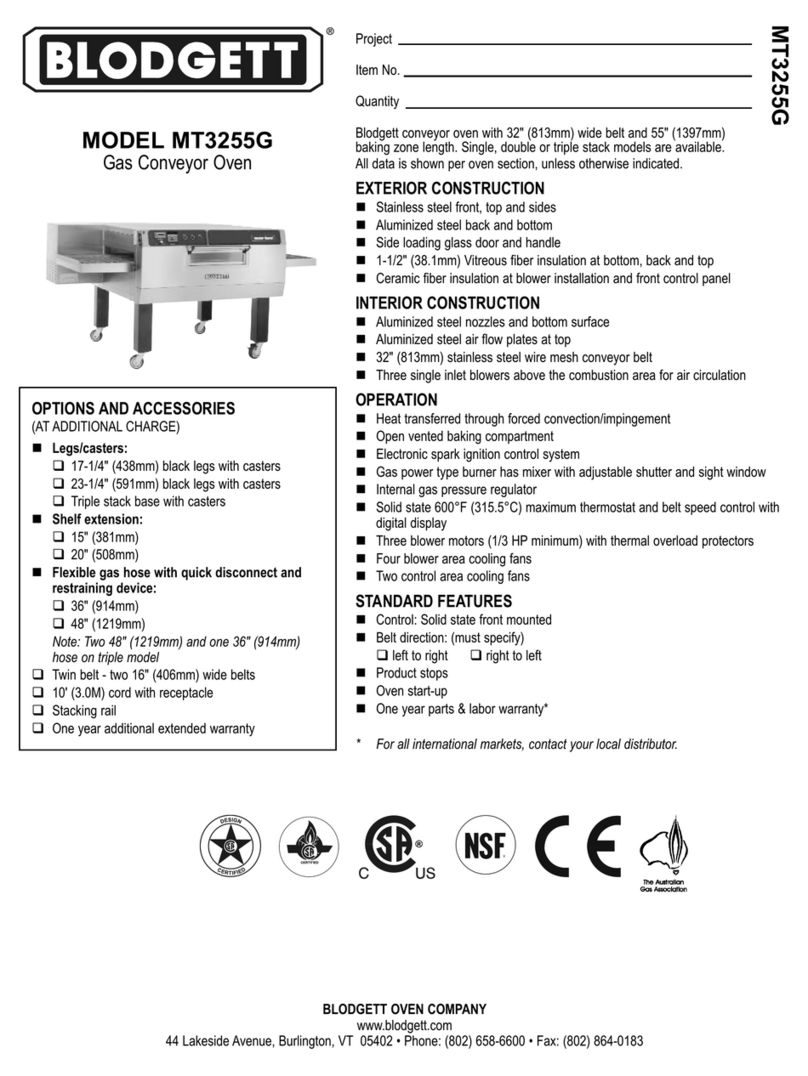
Blodgett
Blodgett MT3255G specification

inventum
inventum OV366CS instruction manual

ninja Kitchen
ninja Kitchen FOODI DT200UK instructions

Samsung
Samsung NV7B565 Series User & installation manual

Galanz
Galanz GTS311S2ETWAQ18 user manual
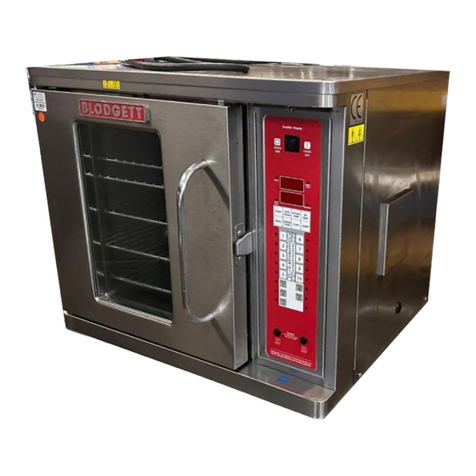
Blodgett
Blodgett CTBR-AP Installation, operation & maintenance instructions
